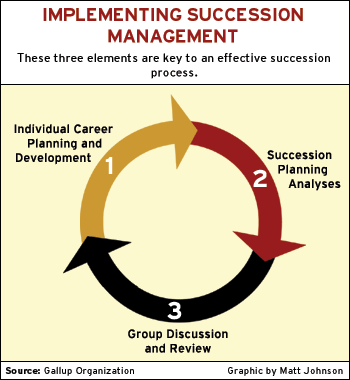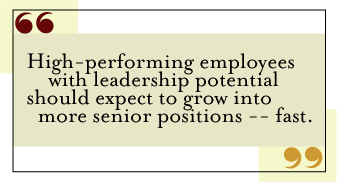Selecting and developing future leaders is critical. Yet most organizations apply little or no rigor to identifying and grooming their top players. This article discusses how to change that.
As noted in the first article in this two-part series, there are three fundamental requirements for effective succession management. Companies that have an effective succession management process:
- quickly anticipate and fill succession gaps
- identify employees with high management potential and actively plan their careers and development to build "bench strength"
- align their people strategy with their business strategy
Only a few companies perform these activities consistently well. When you study these organizations, their practices are impressive and insightful. But how do they implement those practices? And how can you make a similar approach work in your own organization?
 |
There are three elements you need to manage effectively:
- First, make sure the organization understands and nurtures each employee's unique talents and potential through individual career planning and development activities. Best-practice organizations don't leave leadership development to chance; they actively drive a potential leader's growth and development.
- Second, aggregate and evaluate the organization's talent pool to identify potential leadership gaps and suitable candidates.
- Third, ensure that executives make the necessary succession and development decisions through group discussion and review sessions so that the talent requirements of the business are met.
These elements form the architecture of an effective succession management process. This article will discuss each element of the process and provide specific guidelines on how to implement them effectively.
Individual career planning and development
This phase of the process takes place primarily between an employee and his or her manager. Its purpose it to connect the two so the right decisions are made about the employee's career and so the manager can provide needed coaching and support. This phase entails:
- Promoting an ongoing dialogue. The best way to begin the development process is by talking with an employee about her successes, strengths, needs, and aspirations. In most organizations, though, managers don't have these discussions with employees regularly, if at all. All too often, an employee learns that the company has decided it's time for her to move into a different role, yet she's never even talked about this kind of opportunity with anyone. Naturally, this increases the likelihood that the new position is not at all in line with her talents or aspirations.
Best-practice organizations, in contrast, are intentional about initiating development discussions. For instance, several companies use a performance review process that focuses less on a traditional appraisal and more on a developmental conversation. Some call it a discovery interview; others refer to it as a discussion guide. These organizations are increasing the frequency of the discussions as well, with sessions on at least a quarterly basis.
- Avoiding the Peter Principle. Named after Laurence Johnston Peter, the Peter Principle states that in a hierarchy, employees tend to rise to their level of incompetence. And employees will continue to do so if the main criterion for promoting them into a new role is how well they've done in their current role.
Too many companies reward excellent performance by promoting a person out of the very role in which he or she has excelled. Whenever possible, organizations should promote top performers within their roles by stretching their goals, expanding their responsibilities, or providing them with challenging assignments. This encourages them to develop their talents into real strengths, deepening their abilities and enhancing their performance. This strategy promotes world-class performance in every role. (See "Giving Them What They Deserve" in the "See Also" area on this page.)
A manufacturing company implemented this practice by creating five ascending levels for its sales representatives. A junior account rep could be promoted five times while remaining within the sales rep role -- and retire as one of the company's best rewarded top performers.
A healthcare organization divided a previously homogenous nursing function into three levels. The third level carried the most prestigious title and managed the most challenging, complex cases -- cases only the best nurses would be able to manage. This provided well-deserved recognition as well as a new challenge to the top nurses, and it offered a career growth path for all others.
Encouraging employees to grow within their roles does not necessarily mean an end to traditional, hierarchical promotions. High-performing employees with leadership potential and aspirations should expect to grow into more senior positions -- fast. Promoting future executives into positions with more challenging responsibilities is a great way to develop them. To grow, they need a variety of experiences, including meeting a range of challenges while working in different areas of your business and for different managers. To avoid the Peter Principle, however, organizations should diligently assess employees' talents, capabilities, and fit for the new role, not just how they perform in their current role.
- Instilling a coaching culture. Development must be ongoing, not a once-a-year event. It needs to be ingrained into organizational culture, and employees at all levels should expect informal coaching, mentoring, and ongoing feedback. Some companies foster such a culture by introducing "career boards" or encouraging mentor relationships between proven leaders and employees with leadership potential. Others have instituted an effective induction practice that helps managers and employees clarify expectations and build their relationship as employees take on new roles. Again, a well-thought-out discovery interview or discussion guide can provide structure to this process.
Succession planning analyses
With today's software capabilities, many organizations put their succession management systems online. They make their associates responsible for maintaining their own succession profile and encourage managers to search the online talent pool for potential candidates. These systems also make the process more open and transparent. In one company, for example, employees can see the exact positions for which they could be considered. This level of transparency isn't appropriate in every organization, but it benefits those that can provide it.
 |
Some organizations use software systems to analyze their demographic balance and identify gaps in the succession pool. These systems allow the human resources team to fine-tune their hiring plans. Another important method is mapping various team members against a performance and potential axis. These are common and necessary tools that are used for discussion in the staffing review process.
Group discussion and review
Every leadership team should periodically discuss the talent and performance levels in its organization. (See "Evaluating Employee Performance [Part 2]" in the "See Also" area on this page.) Group discussions or staffing reviews are an effective way to create accountability and plan for succession management.
In the review sessions, a leadership team discusses employee performance and the strengths, values, unique capabilities, and growth potential of the employees on the teams that report to them. The review process usually starts at the top, actively driven by the CEO. The leadership team then takes it to the next level in the organization as the process cascades toward middle, and sometimes even front-line, management levels, as it does at IBM, for instance. GE has practiced staffing or talent reviews rigorously for years, and a growing number of leading organizations are adopting the practice.
Here are a few key reasons why your organization should consider making staffing reviews a required element of its succession management process:
- Creating transparency and accountability. Asking executives to discuss employees' performance and potential enhances the rigor and validity of the review. It also significantly increases accountability for employee performance and development. When reviews are conducted annually or semi-annually, the senior leadership team can see who the company's top, middle, and bottom performers are. And, it will become transparent who is effectively developing their top players, filling the gaps in their succession plans, and repositioning employees who don't perform. In several companies, CEOs have instituted quarterly business review meetings, asking executives to report the progress they've made on the priorities and goals that were set during the previous quarterly meeting. Predictable reviews like these keep managers focused and accountable and ensure the necessary follow through.
- Driving strategy. When leadership reviews a team's performance and potential, it is important that they link the succession process to the organization's goals and strategies. They can do this by expanding the discussion to evaluate the team's strengths and vulnerabilities against its business goals and priorities. Questions like these are a good starting point for the discussion: Given our strategy, what are this team's strengths and vulnerabilities? Does the team have the talent and capabilities to deliver on the strategy and accomplish its business goals? Do we need to alter the talent or capability requirements of new hires?
Discussions like these can be invaluable, particularly when the succession management process is centralized and senior leaders from different business units meet with each other in the staffing review sessions. High-potential employees can be brokered across regions and business units, underperforming managers can be more easily recast into roles and areas in which they may perform better, and best practices can become more visible.
Succession management is a delicate practice, but one that is highly valuable if your company aspires to be a leading organization in the future. It requires a solid understanding of the strengths, limitations, and aspirations of employees. And it demands transparency and a disciplined review process that involves all of your organization's leaders.
The bottom line is, strong leadership today doesn't guarantee strong leadership in the future. Leading organizations don't leave succession management to chance. It's one reason they don't just survive -- they thrive.